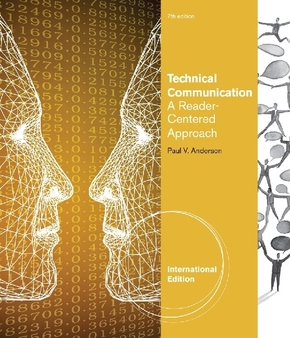Technical Communication - A Reader-Centered Approach. International Edition
Vergleich zu frühere Preisbindung3
| Verlag | Cengage Learning EMEA |
| Auflage | 2010 |
| Seiten | 752 |
| Format | 24,6 cm |
| Gewicht | 1192 g |
| Artikeltyp | Englisches Buch |
| ISBN-10 | 0495803006 |
| EAN | 9780495803003 |
| Bestell-Nr | 49580300E |
Thousands of students have successfully improved their writing and design skills using Anderson's TECHNICAL COMMUNICATION: A READER-CENTERED APPROACH, International Edition. Known for its treatment of the rhetorical situation and coverage of usability and persuasion, this edition contains new chapters and an innovative, visually oriented design that will engage today's students.
Inhaltsverzeichnis:
From the contents:
PART I: INTRODUCTION.
1. Communication, Your Career, and This Book.
Communication Expertise Will Be Critical to Your Success. Characteristics of Workplace Writing. At Work, Writing Is an Action. The Main Advice of This Book: Think Constantly about Your Readers. Qualities of Effective On-the-Job Communication: Usability and Persuasiveness. The Dynamic Interaction between Your Communication and Your Readers. Some Reader-Centered Strategies You Can Begin Using Now. Communicating Ethically. What Lies Ahead in This Book. Guidelines, Your Creativity, and Your Good Judgment. Case: Help Mickey Chelini Select the Right Forklift Truck.
2. Overview of the Reader-Centered Communication Process: Obtaining a Job.
Central Principles of the Reader-Centered Approach. A Reader-Centered Approach to Writing Your Résumé. Writer's Tutorial: Using Tables to Design a Résumé. Electronic Résumés: Special Considerations. A Reader-Centered Approach to Writing Your Job Application Letter. Ethical Issues in the Job Search. Writing for Employment in Other Countries. Interviewing Effectively and Displaying Your Work. Conclusion. Case: Advising Patricia.
PART II: DEFINING YOUR COMMUNICATION'S OBJECTIVES.
3. Defining Your Communication's Objectives: Purpose, Reader, Context.
Guideline 1 Create a Mental Movie of Your Reader in the Act of Reading. Guidelines for Describing Your Communication's Purpose. Guideline 2 Describe the Task Your Communication Will Help Your Reader Perform. Guideline 3 Describe the Way You Want Your Communication to Alter Your Reader's Attitudes. Guidelines for Creating a Profile of Your Reader. Guideline 4 Describe Your Reader's Professional Characteristics. Guideline 5 Global Guideline: Describe Your Reader's Cultural Characteristics. Guideline 6 Learn Who ALL Your Readers Will Be. Guidelines for Understanding Your Reader's Context. Guideline 7 Describe the Context in Which Your Reader Will Read. Guidelines for Other Important Considerations. Guideline 8 Identify Any Constraints on the Way You Write. Guideline 9 Ethics Guideline: Identify Your Communication's Stakeholders. Conclusion. Case: Announcing the Smoking Ban.
PART III: PLANNING.
4. Planning for Usability.
Process for Planning for Usability. Guideline 1 Identify The Information Your Readers Need. Guideline 2 Organize Around Your Readers' Tasks. Guideline 3 Identify Ways to Help Readers Quickly Find What They Want. Techniques for Planning for Usability. Guideline 4 Look for a Technical Writing Superstructure You Can Adapt. Guideline 5 Plan Your Graphics. Guideline 6 Outline, If This Would Be Helpful. Guideline 7 Global Guideline: Determine Your Readers' Cultural Expectations About What Makes a Communication Usable. Guideline 8 Check Your Plans With Your Readers. Guideline 9 Ethics Guideline: Investigate Stakeholder Impacts. Conclusion. Case: Filling the Distance Learning Classroom.
5. Planning Your Persuasive Strategies.
Persuasion to Influence Attitudes and Action. Persuasion to Help a Team Explore Ideas Collaboratively. How Persuasion Works. The Sources of This Chapter's Advice. Guideline 1 Listen and Respond Flexibly to What You Hear. Guideline 2 Focus on Your Readers' Goals and Values. Guideline 3 Address and Learn from Your Readers' Concerns and Counterarguments. Guideline 4 Reason Soundly. Guideline 5 Organize to Create a Favorable Response. Guideline 6 Build an Effective Relationship with Your Readers. Guideline 7 Decide Whether to Appeal to Your Readers' Emotions. ...

